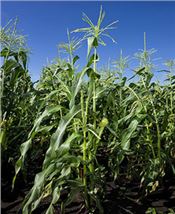ARS, Collaborating Scientists Tackling "Tar Spot" Threat To U.S. Corn

ARS and collaborating scientists have begun a multi-faceted fight against an emerging disease of corn called tar spot.
JAN SUSZKIW
WEST LAFAYETTE, INDIANA
Helping farmers turn the tide on an emerging disease of corn called tar spot is the focus of a multi-organization team of scientists, including from the Agricultural Research Service (ARS) in West Lafayette, Indiana.
Caused by the fungus Phyllachora maydis, tar spot appears as black, roughly circular discolorations on the leaves, husks and stalks of corn plants. A tan halo sometimes surrounds the spore-filled spots, creating what's known as a fish-eye lesion. Outbreaks of the disease, which was first detected in northern Indiana and Illinois in 2015, can reduce grain yields by 20 to 60 bushels an acre. Tar spot is now also found in corn-growing areas of Iowa, Michigan, Minnesota, Missouri, Ohio, Pennsylvania, Wisconsin, Florida, and southwestern Ontario, Canada.
Although fungicides offer the hardest-hitting counterpunch, resistance to tar spot disease in corn is far more preferable, according to Steve Goodwin, a plant pathologist with the ARS Crop Production and Pest Control Research Unit in West Lafayette, IN.
There, in collaboration with fellow ARS scientists Raksha Singh, Matthew Helm and Charles Crane, Goodwin is working to manage tar spot on several research fronts:
Screening existing commercial corn varieties and germplasm lines for their resistance or susceptibility to tar spot so that growers can adjust their disease management practices accordingly.
Developing tools known as molecular markers to quickly and efficiently identify a gene known to confer tar spot resistance in corn, namely Qrtsc8. Identifying corn plants that lack the gene but are still resistant to the disease are also of interest, since an entirely new gene or genes unknown to science could be at play. Potentially, such sources of resistance could also prove useful in shoring up the crop's defenses even further.
Determining the biocontrol potential of a community of microorganisms known as the microbiome that was observed on tar-spot-resistant but not susceptible corn plants. "The main goal is to understand how environmental factors, plant growth stage and the associated corn microbiome affect tar spot disease progression and how all these factors are interconnected," said Raksha.
Identification of several proteins the tar spot fungus uses to "short circuit" the defenses of susceptible plants – and how, in turn, these proteins could be exploited for better detection of different strains of the fungus and their severity in fields, noted Helm.
On other fronts, university collaborators are conducting research to optimize the timing of fungicide sprays and evaluating rotations of corn with non-host crops to reduce the disease's severity and prevent the fungus from surviving the winter on debris from prior corn harvests.
Researchers are also pouring through existing literature on the biology of the tar spot fungus and building on what's known about it with genomic sequencing – a kind of decoding of its DNA playbook for causing disease in corn. One hope is that this will yield clues to new ways of controlling the fungus and preempting costly outbreaks like the one from 2018 to 2020, which claimed an estimated 241 million bushels of U.S. corn.
The effort is being carried out under the auspices of the National Plant Disease Recovery System (NPDRS). Arising from a 2004 Homeland Security Presidential Directive, the NPDRS spotlights emerging plant disease threats and identifies what tools, infrastructure, communication networks and other resources will be necessary to protect U.S crops or recover from outbreaks that have already occurred. ∆
Article from USDA/ARS